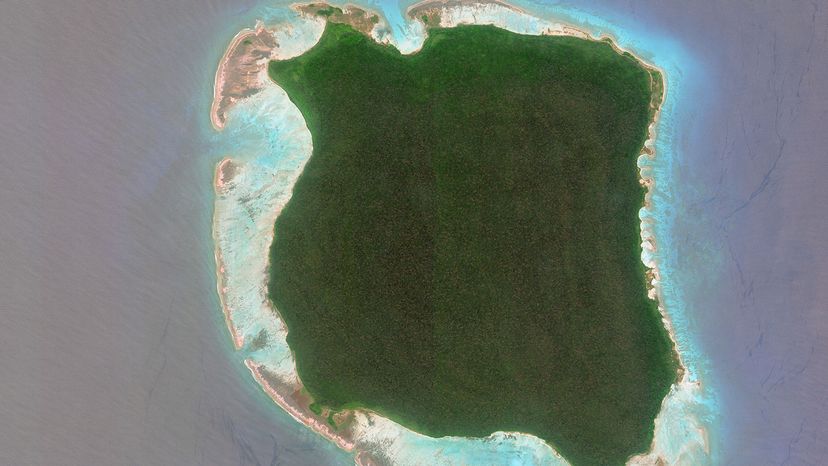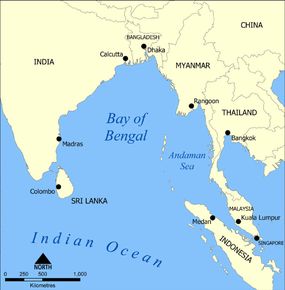
The inhabitants of North Sentinel Island may be the last uncontacted people on Earth. And they'd sure like to keep it that way.
For centuries, the isolated, Indigenous people of North Sentinel Island (known as the Sentinelese) have rejected all attempts by the outside world to infiltrate their tiny tropical home in the Bay of Bengal. In fact, anthropologists have no idea how many Sentinelese live on the island — estimates vary between 50 and 500.
HSW General Knowledge Trivia 1
In 2018, North Sentinel Island made the news when a young American missionary named John Allen Chau was killed on the island after repeatedly ignoring the Sentinelese's warnings to stay away. Chau was only the latest in a long line of unwelcomed outsiders — merchants, escaped convicts, fisherman and filmmakers — whose intrusions onto North Sentinel Island have been met with an angry volley of arrows.
But the few tantalizing glimpses of life on North Sentinel Island paint an intriguing picture of an untouched, hunter-and-gatherer society. The islanders live in primitive huts, spearfish from dugout canoes and wear no clothing at all. What's amazing is that this almost Neolithic society exists less than 20 miles (32 kilometers) from neighboring islands where Indigenous cultures have mixed with the modern world, not always with happy results.
"[These tribes] have been living on the islands for centuries without any problem. Their troubles started after they came into contact with outsiders," said Madhumala Chattopadhyay, an Indian anthropologist, in an interview for National Geographic. She was the first woman to visit North Sentinel Island in the 1990s but has vowed never to go back. "The tribes of the islands do not need outsiders to protect them, what they need is to be left alone."
Contents
The History of North Sentinel Island
North Sentinel Island is part of a much larger island chain called the Andaman and Nicobar Islands, currently governed by India. There are 184 islands in this tropical archipelago located in the Bay of Bengal about 300 miles (500 kilometers) off the coast of Myanmar (Burma) and 700 miles (1,200 kilometers) from India. Only about 30 of the islands in the chain are inhabited and are home to Indigenous people like the Onge and the Jarawa, who speak different languages than the Sentinelese.

NormanEinstein/Wikipedia/CC BY-SA 3.0
In the 18th century, the Andaman and Nicobar Islands were first explored by Dutch, Austrian and British merchant ships looking for the best trade routes to the spice-rich Asian subcontinent. In 1771, a ship with the British East India Company was the first to spot signs of life on North Sentinel Island, cooking fires flickering in the night.
The first permanent European settlers arrived in the Andaman and Nicobar Islands in the 1850s when the British built a penal colony on Grand Andaman Island, about 30 miles (50 kilometers) from North Sentinel Island, to house colonial prisoners from British-ruled India. In 1896, a prisoner tried to escape on a raft and washed up on the beach of North Sentinel Island. A search party found him a few days later, dead from multiple arrows.
The prisoner's death confirmed previous reports from a shipwrecked merchant vessel of "small naked men firing arrows" on North Sentinel Island. The island and its unwelcoming inhabitants remained unmolested for another half century.
Anthropologists Try to Make Contact
In 1967, the Anthropological Survey of India sent a team of 20 people (including police and Indian naval personnel) to attempt to make peaceful contact with the Sentinelese, who were known to fire arrows at any fishing vessel or naval ship that got too close to its beaches. But instead of being greeted with the usual hostility, the anthropologists landed their boat on an empty beach with no people in sight.
In fact, during the anthropologists' first trip to the island, they saw no Sentinelese at all. According to TN Pandit, one of the leaders of the anthropological expedition, the Sentinelese must have seen the outsiders coming and gone into hiding.
Pandit and his team followed footprints into the jungle until they came to a clearing with what he described as 18 "nicely built" lean-to huts. Each home had a well-tended fire in front of it, and hastily abandoned meals of roasted fish and fruits. He estimated that 40 to 50 people lived in the village.
The anthropologists left gifts for the Sentinelese — coconuts (which don't grow on the island), iron rods and plastic utensils — but when they attempted to make return visits in the 1970s and 80s, they were repelled each time.
The Closest Thing to Peaceful Contact
In the early 1990s, the Anthropological Survey of India made another attempt at peaceful contact with the Sentinelese, and for the first time ever, the outreach team included a woman. Madhumala Chattopadhyay was an anthropologist who specialized in the Indigenous tribes of the Adnaman and Nicobar Islands but had never been to North Sentinel. Both Chattopadhyay and her parents were required to sign waivers acknowledging the danger of the expedition.
When the team arrived, there were the usual armed men on the beach, but instead of gesturing angrily and firing their weapons, the Sentinelese calmly walked toward the shoreline.
"We started floating coconuts over to them," recalled Chattopadhyay in a National Geographic article. "To our surprise some of the Sentinelese came into the water to collect the coconuts."
Perhaps it was the presence of a woman, but for some reason the Sentinelese let down their guard. Some of the tribesmen waded out to the boat and examined it. They happily accepted all of the coconuts. They even allowed some of the outsiders to walk around the beach and interact with Sentinelese women, teenagers and children. But they weren't allowed to enter the jungle or see the village.
Encouraged, the anthropologists returned a few months later with a much larger team. But the interaction quickly soured. The Sentinelese weren't satisfied with collecting floated coconuts, so they boarded the ship and took the whole bag. One Sentinelese man even tried to grab one of the policemen's rifles, mistaking it for just another scrap of metal. The police officer forcefully took it back.
"The man got angry and whipped out his knife," said Chattopadhyay. "He gestured to us to leave immediately and we left," she says.
Death of an American Missionary on North Sentinel Island
Since 1996, it's been illegal for fisherman, tourists, researchers or other civilians to approach or land on North Sentinel Island. In 2006, two Burmese fishermen made an emergency landing on the island and were killed by the Sentinelese, their bodies buried in the sand.
But that wasn't going to stop John Allen Chau, a 26-year-old evangelical Christian missionary and adventure blogger who hired local fishermen to take him to North Sentinel Island in 2018. Chau was part of an international movement of young adventurers who yearned to bring Christianity to the "unreached" corners of the globe.
Chau was a well-trained outdoorsman, according to an in-depth profile in The Guardian, and he submitted to several rounds of vaccinations to ensure that he didn't bring any outside diseases to the Sentinelese. Chau chronicled his missionary trip in a diary and came prepared to deal with any "contingencies" of contact with hostile residents, including dental forceps for removing arrows. When Chau first waded up to the Island, he brought a large fish as a gift.
"I hollered 'my name is John, I love you and Jesus loves you,'" Chau wrote in his diary. The Sentinelese responded with arrows. Chau came back and dodged even more arrows, including one shot from a young boy that pierced Chau's waterproof Bible, according to another profile in The New Yorker.
"If you want me to get actually shot, or even killed with an arrow then so be it," wrote Chau in his diary that night. "I think I could be more useful alive though, but to you, God, I give all the glory of whatever happens. I DON'T WANT to die."
Tragically, that's exactly what happened. According to the fisherman who smuggled Chau to the island, they saw the Sentinelese drag his body to the beach and bury it. The Indian government was unable to recover Chau's remains.